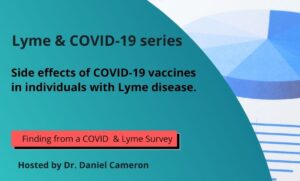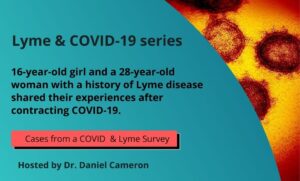Call for your appointment today 914-666-4665 | Mt. Kisco, New York

HIGHLIGHTS
Question: What is the clinical presentation of someone with a history of Lyme disease who have contracted a COVID-19 infection?
Findings: This cross-sectional Survey reveals a high symptom burden in 1168 individuals with a history of Lyme Disease. The symptom burden was the highest for the 288 individuals with a history of Lyme disease and a COVID-19 infection. Nearly one in five individuals with a history of COVID-19 and Lyme disease developed long COVID. Twenty were hospitalized.
Meaning: Individuals with a history of Lyme disease and COVID-19 have a high symptom burden and are at increased risk of hospitalization and long COVID.
Background, method, results, and conclusion
There has been a broad range of conditions described in COVID-19, including long COVID. The symptoms of long COVID, including pain-related symptoms, fatigue, psychological disorders, cognitive impairment, sensory impairment, and functional impairments, are similar to Lyme disease symptoms.1-3
But what are the symptoms and their burden for individuals with a history of Lyme disease and COVID-19? In this cross-sectional Survey, 288 individuals fitting this description shared their experiences.
Methods
These findings summarize the results of a cross-sectional descriptive survey investigating the burden of Lyme disease. While the 1,168 respondents may have contracted COVID-19, and may have taken the COVID-19 vaccine, these findings pertain only to those 288 individuals with a history of Lyme disease and a COVID-19 infection, regardless of whether or not they had been vaccinated against COVID-19. Participants were recruited through a snowball sampling strategy via social media. This Survey was conducted in accordance with the Declaration of Helsinki and approved by the Western Institutional Review Board.
The GSQ-30 questionnaire is a brief self-report scale designed to assess the symptom burden in Lyme disease (LD). The GSQ-30 asks, “How much have you been bothered by any of the following?” for each of 30 items, that in tandem assess four domains, with each item rated on a five-point Likert scale. Responses include “Not at all,” “A little bit,” “Somewhat,” “Quite a bit,” and “Very much” (scored 0-4, for a total score of up to 120). Each domain is relevant to LD (pain/fatigue, neuropsychiatric, neurologic, and viral-like symptoms).1
Symptom burden of individuals with a history of Lyme disease and COVID-19
The GSQ-30 measure of symptom burden for 288 individuals with a history of Lyme disease and COVID-19 was significantly higher than the symptom burden for 715 individuals with a history of Lyme disease who have not had COVID-19 (48.2 vs. 43.1, p = 0.008). Moreover, the GSQ-30 measure of symptom burden for 288 individuals with a history of Lyme disease and COVID-19 was greater than for healthy controls (mean=6.00) and patients with an erythema migrans (EM) rash (mean=24.15), traumatic brain injury (TBI) (mean 32.28), depression (mean 42.28), and PTLDS, (mean 42.38) described in a validation paper.1
The most common symptom cluster in individuals with a history of Lyme disease was pain/fatigue, followed in rank order by neuropsychiatric symptoms, neurologic symptoms, and flu-like symptoms.
The most common symptoms were:
- Feeling fatigued or having low energy
- Feeling worse after normal physical activity
- Not feeling rested on awakening
- Muscle aches or pains
- Trouble falling or staying asleep
- Needing more sleep than usual
- Feeling panicky, anxious or worried
- Trouble finding or retrieving words
- Stiff or painful neck
- Joint pain or swelling
The most common chronic manifestations of the 288 individuals with a history of Lyme disease and COVID-19 were long COVID (20.1%) and shortness of breath (19.8%). A loss of smell (19.4%) and loss of taste (16.3%) were less common. A loss of taste (34%) and taste (28%) was common post recovery from COVID-19 in a retrospective study in Australia.1 Pneumonia (4.9%) and a clotting disorder (1.7%) were the least common. The risk of lung complications that lead to admission has been estimated to be 3 to 7% by the CDC.2 The actual number of cases of lung complications varies by the population studied. The risk of a thrombotic event including deep vein thrombosis (DVT), pulmonary embolism, and arterial thromboses was 3.1% in a cohort of 2748 hospitalized patients.3
Of 288 individuals with a history of Lyme disease and COVID-19, only 20 were hospitalized (7%), and 12 needed supplemental oxygen. Three were hospitalized and put on non-invasive ventilation or high-flow oxygen devices (e.g., CPAP).
Discussion
The symptom burden for individuals with Lyme disease was high even without COVID-19. However, the symptom burden for individuals with a history of Lyme disease was significantly worse for those who have had COVID-19.
One out of five individuals with a history of Lyme disease and COVID-19 in this Survey developed long COVID. This ratio was considerably smaller in the general population, with nearly one in 10 individuals without a history of Lyme disease (9.8%) in a broad Primary Care Patient Population developing long COVID.4 Similarly, one in ten individuals with COVID-19 reported ongoing symptoms for more than 12 weeks following their COVID-19 infection in a UK study.4 While the survey was not designed to determine the causes of long COVID in individuals with a history of Lyme disease and COVID-19, these findings speak to the prevalence of the issue and its associated symptoms.
Many of the symptoms of individuals with a history of Lyme disease and COVID-19 were similar to individuals without Lyme disease who have long COVID. In a systematic review and meta-analysis of long COVID, the five most common symptoms were fatigue (58%), headache (44%), attention disorder (27%), hair loss (25%), and dyspnea (24%).5 These findings were mirrored in a systematic review of 10,951 people, which reported the five most common symptoms as weakness, general malaise, fatigue, concentration impairment, and breathlessness.6
The hospitalization rate of 7% for individuals with a history of Lyme disease and COVID-19 has been described here for individuals without a history of Lyme disease. This was higher than, but comparable to the rate of hospitalization reported at less than 5% in a community-based SARS-CoV-2 testing in England during a survey from November 23, 2020, to January 31, 2021.7 If this difference is found to be replicable, the higher rate of hospitalization in those with Lyme disease may be related to compounding effects of the disease and its chronic manifestations.
There are several limitations to this survey. First, a cross-sectional approach does not provide evidence for causality as the data represent a snapshot of time. A longitudinal design will be needed to address changes over time and causality. Second, the Survey may be subject to volunteer bias, where participants who actively decide to participate in the research may differ from the general population of individuals with a history of Lyme disease. Third, the Survey was not designed to determine if the ongoing symptoms were related to a persistent tick-borne infection and may be related to comorbid conditions.
Conclusions
Individuals with a history of Lyme disease and COVID-19 have a higher symptom burden and are at increased risk of hospitalization and long COVID, relative to those with Lyme disease who have not contracted COVID-19.
Call for Survey participants to share their experience
As of December 2021, 1,168 individuals had shared their experience in this COVID-19 and Lyme disease Survey. The Survey is still open and expected to offer more insights into the effects of Lyme disease with or without a COVID-19 infection or COVID-19 vaccine. If you or someone you know are able to share your experiences, please click here to participate in the survey. Click here to participate in the Survey.
About the COVID Lyme Survey:
This is the largest clinically-based survey of individuals with a history of Lyme disease with or without a COVID-19 infection or COVID-19 vaccination.
References:
- Fallon BA, Zubcevik N, Bennett C, et al. The General Symptom Questionnaire-30 (GSQ-30): A Brief Measure of Multi-System Symptom Burden in Lyme Disease. Front Med (Lausanne). 2019;6:283. doi:10.3389/fmed.2019.00283
- Hayes LD, Ingram J, Sculthorpe NF. More Than 100 Persistent Symptoms of SARS-CoV-2 (Long COVID): A Scoping Review. Front Med (Lausanne). 2021;8:750378. doi:10.3389/fmed.2021.750378
- Logigian EL, Kaplan RF, Steere AC. Chronic neurologic manifestations of Lyme disease. N Engl J Med. Nov 22 1990;323(21):1438-44. doi:10.1056/NEJM199011223232102
- Jones R, Davis A, Stanley B, et al. Risk Predictors and Symptom Features of Long COVID Within a Broad Primary Care Patient Population Including Both Tested and Untested Patients. Pragmat Obs Res. 2021;12:93-104. doi:10.2147/POR.S316186
- Lopez-Leon S, Wegman-Ostrosky T, Perelman C, et al. More than 50 Long-term effects of COVID-19: a systematic review and meta-analysis. medRxiv. Jan 30 2021;doi:10.1101/2021.01.27.21250617
- Michelen M, Manoharan L, Elkheir N, et al. Characterising long COVID: a living systematic review. BMJ Glob Health. Sep 2021;6(9)doi:10.1136/bmjgh-2021-005427
- Nyberg T, Twohig KA, Harris RJ, et al. Risk of hospital admission for patients with SARS-CoV-2 variant B.1.1.7: cohort analysis. BMJ. Jun 15 2021;373:n1412. doi:10.1136/bmj.n1412
Links to Lyme and COVID-19 series
- Severity of Lyme disease in a COVID-19 pandemic
- A 16-year-old girl and a 28-year-old woman with a history of Lyme disease shared their experiences after contracting COVID-19 – case discussion
- The experiences of individuals with a history of Lyme disease who contracted COVID-19
- 28-year-old woman with a history of Lyme disease describes side effects following her COVID-19 vaccine – a case discussion
- Side effects of COVID-19 vaccines in individuals with Lyme disease
- A 45-year-old woman who has been hesitant to take the COVID-19 vaccine. Next Lyme science blog
- Concerns of individuals with a history of Lyme disease who have been hesitant or have refused to take the vaccine. next Lyme science blog



